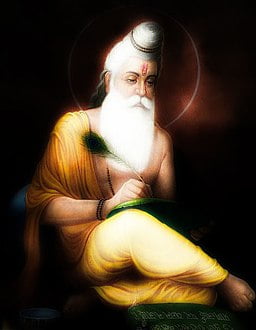Veda Vyasa is credited with dividing the Vedas into four traditional collections.
Veda Vyasa, also known as Krishna Dvaipayana or Vedavyasa, is a revered sage portrayed in most Hindu traditions.
He is traditionally regarded as the author of the epic Mahabharata, a collection of legendary and didactic poetry worked around a central heroic narrative.
In addition to his literary achievements, Veda Vyasa is considered a great yogi, philosopher, and preacher of Krishna bhakti.
He is also celebrated as a nation-builder who helped revolutionize, reorganize, and reform Hinduism.
He is said to have classified the Vedas into four parts based on their content and purpose and then taught them to his four disciples.
The four Vedas are:
- Rigveda: A collection of hymns and mantras used in Vedic rituals.
- Yajurveda: A collection of sacrificial formulas used by priests during Vedic rituals.
- Samaveda: A collection of melodies and chants used in Vedic rituals.
- Atharvaveda: A collection of hymns, spells, and incantations used in Vedic rituals.
Veda Vyasa had four chief disciples to whom he taught the four Vedas.
The disciples and their respective Vedas are:
- Paila: Rigveda.
- Vaishampayana: Yajurveda.
- Jaimini: Samaveda.
- Sumantu: Atharvaveda.
According to the Vishnu Purana, Veda Vyasa divided the Puranas into three categories based on their content and purpose.
The three categories are:
- Sattva Puranas: These Puranas glorify Lord Vishnu. They include the Vishnu Purana, Bhagavata Purana, Narada Purana, Garuda Purana, Padma Purana, and Varaha Purana.
- Rajas Puranas: These Puranas glorify Lord Brahma. They include the Brahma Purana, Brahmanda Purana, Brahma Vaivarta Purana, Markandeya Purana, Bhavishya Purana, and Vamana Purana.
- Tamas Puranas: These Puranas glorify Lord Shiva. They include the Shiva Purana, Linga Purana, Skanda Purana, Agni Purana, Matsya Purana, Kurma Purana, and Vayu Purana.
The Sattva Puranas are said to be more philosophical and spiritual in nature than the other Mahapuranas. They focus on themes such as the nature of reality, the path to liberation, and the worship of Vishnu.
The classification of the Puranas into Sattva, Rajas, and Tamas is not universally accepted. Some scholars argue that the Puranas are too diverse to be neatly categorized in this way.
However, the Sattva Puranas remain an important part of the Hindu tradition and are widely read and studied by Hindus around the world.
Here are some of the common themes found in the Sattva Puranas:
The importance of devotion to Vishnu.
The concept of karma and reincarnation.
The path to liberation from samsara.
The nature of reality as oneness or non-duality.
The importance of spiritual practices such as yoga and meditation.
Image credit:
Nahsik01, CC BY-SA 4.0, via Wikimedia Commons